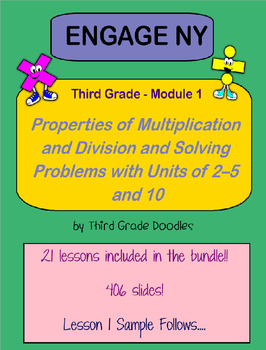Third Grade Engage New York Module 1 -- Smartboard Lessons
Third Grade Doodles
3.6k Followers
Grade Levels
3rd
Subjects
Resource Type
Standards
CCSS3.OA.A.1
CCSS3.OA.A.2
CCSS3.OA.A.3
CCSS3.OA.A.4
CCSS3.OA.B.5
Formats Included
- NOTEBOOK (SMARTboard) File
Pages
406 pages
Third Grade Doodles
3.6k Followers
Description
Do you use Engage NY? Do you have a Smart Board?
If you answered YES, then your life just got A LOT easier!
I have used this module with my own students and LOVED IT! It is the best series of lessons for teaching multiplication and division concepts effectively. You can download the lessons and all worksheets at the Engage NY website.
This product includes Smart Board slides for each lesson.....a total of 406 slides!
These slides are interactive and engaging and will save you a ton of work. Simply cue up the slides and you are ready to teach. I have included the teacher dialogue to make things easy for you!
Slides include simple, yet engaging graphics that will be super easy for your students to follow....check out the preview to see the complete first lesson.
Your students will need white boards (which can easily be made by slipping plain white paper into a sheet protector), and dry erase markers. That's about it! Engage NY provides all necessary materials for each lesson.
I hope you like this Smart Board product...please let me know if it does not make teaching this unit a BREEZE! Questions and suggestions are always welcome!
Happy Teaching!
Kathy Olenczuk
Third Grade Doodles
If you answered YES, then your life just got A LOT easier!
I have used this module with my own students and LOVED IT! It is the best series of lessons for teaching multiplication and division concepts effectively. You can download the lessons and all worksheets at the Engage NY website.
This product includes Smart Board slides for each lesson.....a total of 406 slides!
These slides are interactive and engaging and will save you a ton of work. Simply cue up the slides and you are ready to teach. I have included the teacher dialogue to make things easy for you!
Slides include simple, yet engaging graphics that will be super easy for your students to follow....check out the preview to see the complete first lesson.
Your students will need white boards (which can easily be made by slipping plain white paper into a sheet protector), and dry erase markers. That's about it! Engage NY provides all necessary materials for each lesson.
I hope you like this Smart Board product...please let me know if it does not make teaching this unit a BREEZE! Questions and suggestions are always welcome!
Happy Teaching!
Kathy Olenczuk
Third Grade Doodles
Total Pages
406 pages
Answer Key
N/A
Teaching Duration
1 month
Report this resource to TPT
Reported resources will be reviewed by our team. Report this resource to let us know if this resource violates TPT’s content guidelines.
Standards
to see state-specific standards (only available in the US).
CCSS3.OA.A.1
Interpret products of whole numbers, e.g., interpret 5 × 7 as the total number of objects in 5 groups of 7 objects each. For example, describe a context in which a total number of objects can be expressed as 5 × 7.
CCSS3.OA.A.2
Interpret whole-number quotients of whole numbers, e.g., interpret 56 ÷ 8 as the number of objects in each share when 56 objects are partitioned equally into 8 shares, or as a number of shares when 56 objects are partitioned into equal shares of 8 objects each. For example, describe a context in which a number of shares or a number of groups can be expressed as 56 ÷ 8.
CCSS3.OA.A.3
Use multiplication and division within 100 to solve word problems in situations involving equal groups, arrays, and measurement quantities, e.g., by using drawings and equations with a symbol for the unknown number to represent the problem.
CCSS3.OA.A.4
Determine the unknown whole number in a multiplication or division equation relating three whole numbers. For example, determine the unknown number that makes the equation true in each of the equations 8 × ? = 48, 5 = __ ÷ 3, 6 × 6 = ?.
CCSS3.OA.B.5
Apply properties of operations as strategies to multiply and divide. Examples: If 6 × 4 = 24 is known, then 4 × 6 = 24 is also known. (Commutative property of multiplication.) 3 × 5 × 2 can be found by 3 × 5 = 15, then 15 × 2 = 30, or by 5 × 2 = 10, then 3 × 10 = 30. (Associative property of multiplication.) Knowing that 8 × 5 = 40 and 8 × 2 = 16, one can find 8 × 7 as 8 × (5 + 2) = (8 × 5) + (8 × 2) = 40 + 16 = 56. (Distributive property.)





